Excerpts from my Autumn trip to Enschede, Holland
(Czech version here.)
I went to this relatively small town in October 1995. It is known primarily
as a seat of Twente University and for its university campus.
If you would like to find it on a map, search close to the German border.
This proximity was a drawback back in the town's history - during WW2, Allied
forces had bombed that area when they flew to bomb Germans.
October is probably not the best time of the year to visit Holland - there
were almost constant showers and foggy during my visit.
You may guess that nevertheless, I took my camera with me again. I accepted
an invitation from my Czech friend, who is on a stage at Twente University.
Click on the pictures if you want to see them in normal size.
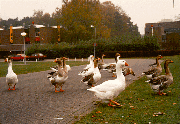 This is a typical view from the university campus. Dutch people seem to
like geese very much.. I say this because special traffic lights had been
built for the geese at their crossing. If you want to know where are they
going now, see the next picture.
This is a typical view from the university campus. Dutch people seem to
like geese very much.. I say this because special traffic lights had been
built for the geese at their crossing. If you want to know where are they
going now, see the next picture.
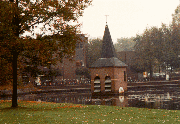 So, here it is - it's the lake, where the geese spend most of their time.
If you are just passing by, they don't seem to notice you, but if you stop,
they get out of the water to check out what kind of food you have brought
for them.
So, here it is - it's the lake, where the geese spend most of their time.
If you are just passing by, they don't seem to notice you, but if you stop,
they get out of the water to check out what kind of food you have brought
for them.
You may wonder why there's a spire peeking out of the water - that's Dutch
sense of humour :-) (It is part of the lake design)
Not far from this place you can also find a huge artificial can with sardines
hidden underneath the trees.
 I took this picture on my first visit to the Enschede historical center.
It is located in the corner of the main square. That was another rainy day,
so it was risky bussiness to try to take some pictures - there wasn't light
enough althought I had 800ASA film.
I took this picture on my first visit to the Enschede historical center.
It is located in the corner of the main square. That was another rainy day,
so it was risky bussiness to try to take some pictures - there wasn't light
enough althought I had 800ASA film.
Well, it could have been worse.
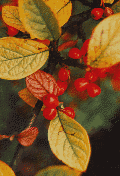 Later that same day, these shiny red fruits on an Autumn-coloured bush caught
my eyes. I haven't any slightest idea what kind of bush this could be, but
the rain made its colors even more intense.
Later that same day, these shiny red fruits on an Autumn-coloured bush caught
my eyes. I haven't any slightest idea what kind of bush this could be, but
the rain made its colors even more intense.
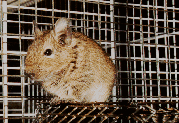 You are right, this is definitely nothing unique to Holland. How did it
came to pass that I have taken this picture? I got soaked through by the
rain, so I decided to dry a little bit in a local pet shop. I asked for
permission to take some pictures of their animals, and this is one of them.
You are right, this is definitely nothing unique to Holland. How did it
came to pass that I have taken this picture? I got soaked through by the
rain, so I decided to dry a little bit in a local pet shop. I asked for
permission to take some pictures of their animals, and this is one of them.
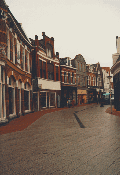 This is one of the streets that go around the main square in a circular
manner. It is also part of the historical center. Houses are not very high:
two or three floors, not more. And of course, shops are everywere. There,
you can buy whatever you like. Mac Donald was desperately deserted...
This is one of the streets that go around the main square in a circular
manner. It is also part of the historical center. Houses are not very high:
two or three floors, not more. And of course, shops are everywere. There,
you can buy whatever you like. Mac Donald was desperately deserted...
 These are traditional Dutch folk shoes made out of wood. They call them
"klompen" and as you can see in the picture of the Lonnekker windmill below,
some people are still accustomed to wearing them to work - especially in
the field. They say these shoes are very practical for the garden as well.
These are traditional Dutch folk shoes made out of wood. They call them
"klompen" and as you can see in the picture of the Lonnekker windmill below,
some people are still accustomed to wearing them to work - especially in
the field. They say these shoes are very practical for the garden as well.
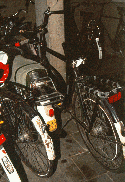 Bicycles on the base floor of a campus dorm. You can rarely see a bike in
a good shape - they are in permanent use and once they are no longer functional,
they are tossed away. I borrowed my Czech friend's bicycle - it's the only
practical means by which you can get from campus to the town. Buses have
long intervals, and tickets are quite expensive.
Bicycles on the base floor of a campus dorm. You can rarely see a bike in
a good shape - they are in permanent use and once they are no longer functional,
they are tossed away. I borrowed my Czech friend's bicycle - it's the only
practical means by which you can get from campus to the town. Buses have
long intervals, and tickets are quite expensive.
Some say the bicycles are stolen quite often...
Lonneker Mill
Legend:
Stone flour-mill. Built in 1851 by the family Blijdenstein.
Height: 27.35 meters
Span: 23.75 meters
Owned by the city of Enschede, managed by the foundation Lonneker Molen.
Renovated in 1985.
Other mills in the world.
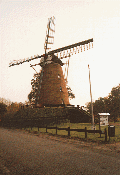
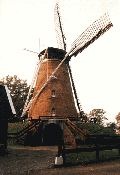
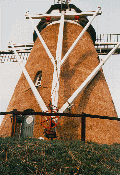
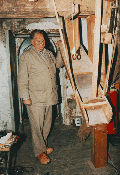
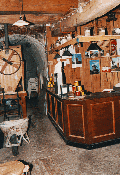
Before my first visit to town, I had borrowed a map of the center of the
town. There was a symbol on the map marked "Information Center", so I decided
to go there. I asked the people there for a better map of the town. I got
new map from them. On this new map was a symbol for a windmill. It was a
must to have gone there.
Here you are - Lonneker windmill.
The very first picture shows it as a whole - the other two pictures show
more details. What you see on its surface is not a plaster. It is made of
many straws stacked closely together, cut to form that rough surface. The
picture with the man was taken on the first floor of the mill - you can
get in and out of it by the small green doors found in the third picture.
The rightmost picture shows the interiors of the ground floor.
I managed to arrive late, after opening hours, but luck was on my side.
After taking a couple of pictures outside, I was about to leave, when a
man in a car arrived. This man tended to and maintained the mill. Have you
noticed his shoes - what else would you wear when driving a car?!
We had an interesting talk - I spoke to him in English, and he spoke to
me in Dutch, but we understood each other quite well. I asked him if I could
see it from inside, and he let me move freely around "his" mill.
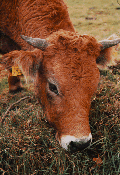 Dutch cows are more hairy than ours. They seem more elegant to me. And of
course, they are also very curious when someone stops by. Village people
never stare at them for so long!
Dutch cows are more hairy than ours. They seem more elegant to me. And of
course, they are also very curious when someone stops by. Village people
never stare at them for so long!
Yes, you got it - I'm a city child.
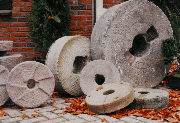 Wanna grinder a stone or two? Or three?
Wanna grinder a stone or two? Or three?
How about a Japanese garden? Everything that you can stick into your garden
is available at this open-air gardening shop. Let yourself be inspired -
dwarfs in terracota are especially cute!
There was also something like a 3-D garden catalogue -- there were two
rows of miniature gardens (3x3m), and each of these showed a different style
of Japanese gardens. There was a path in between, so you could walk and
browse on the left and right, choose the garden number "8" or number "15"
and buy it for home.
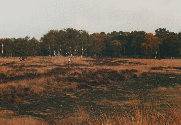 I made a one-day trip to see my Dutch friends in Nijmegen. I went there
by train. I wish we in Czech Republic, had as effective a railways' system
as the Dutch people have! You won't get lost, the trains are not dirty,
intervals are short and you go fast.
I made a one-day trip to see my Dutch friends in Nijmegen. I went there
by train. I wish we in Czech Republic, had as effective a railways' system
as the Dutch people have! You won't get lost, the trains are not dirty,
intervals are short and you go fast.
We went to the Kroller-Miller Museum, which is located inside a big preserved
park. Kroller-Miller has many world reknown works of Vincent v. Gogh, P.
Gaugin, ... pictures, sculptures, objects. The park is a very pleasant place
to stay.
Original Dutch landscape looked like on this picture.
Wissink wind mill
Legend:
This standard flour-mill, also called Stenderkast, was founded in 1802 by
Jan Hendrik Wissink (born 1762), and has milled the grain of the farmers
of Ussel for almost 120 years.
Because of modern developments, the mill was threatened at one point. On
initiative of J.J. van Deinse (a regional historican), the mill was saved
and bought by J.B. van Heek (a known industrialist and protector of culture).
Van Heek had it moved in 1921 to the Buurserzand where he wanted to create
a open-air museum. This, however, was not realized because of his death
in 1923. The mill lead a lonely existence, first under care of the Foundation
Edwina van Heek, later under care of Natuurmonumenten (environmental organisation).
The mill had to be demolished because of heavy storm damage in 1972. This
stimulated ideas of rebuilding it on its original spot in Usselo. At long
last, the mill was opened with great festivities on Molendag (national mills
day) in 1982.
Repair and replacement were made possible primarily by Natuurmonumenten,
Foundation De Overijsselse Molen (the mill of Overijssel), the Foundation
Edwina van Heek, and the Association Wissinks Molen.
The mill is to be visited freely from May to October every first Saturday
of the month (when the flag or pennon is hoisted), and on other occasions
after arrangements. The mill is managed by the foundation Wissinks Molen.
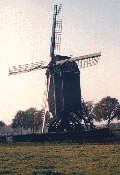
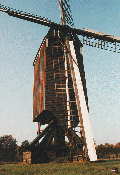
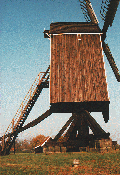
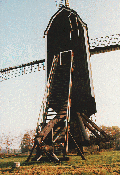
This is another wind mill I never would have found if it weren't for the
help of my Czech friend. He had been busy, so we went there in the night
- not too much was seen. The next day, I went there alone and got lost a
little bit, because I wanted to get out of the highway bicycle path. With
a little help from a Dutch woman, I found the right direction again, and
I then completed my mission without problems.
This mill is made of wood. It is anchored by big stones, on whose surface
appears some engraved text - it was probably something about its owners
and history.
Unfortunately, this mill stand next to a big fence for cattle. It was that
kind of fence with electricity, so I didn't try to pass over it to have
a better view for shooting picutres.
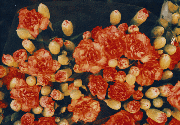 These flowers remind me of a market-place, where you can see and buy many
interesting or tasty things, including fruits, vegetables, fried fishes,
raw fishes and seafood, cheeses, klompen, flowers, Vietnameese-like take-away
food, home electro-appliances, cloths, table cloths, salami & wurst, nuts
& banana chips...
These flowers remind me of a market-place, where you can see and buy many
interesting or tasty things, including fruits, vegetables, fried fishes,
raw fishes and seafood, cheeses, klompen, flowers, Vietnameese-like take-away
food, home electro-appliances, cloths, table cloths, salami & wurst, nuts
& banana chips...
Dutch people are known for growing tulips, but it wasn't the right time
of year for tulips - but still they offered you other kinds of flowers in
an unbelievable number of colourful varieties.
Special thanks to all who showed me such kindness and hospitality on my
trip, and to Harry v. Hoof who translated the wind mill legend - I sent
him the Dutch text one morning via email, and he promptly did the translation
for me during his lunch break!
Text & photos by Jarmila Pankova.
 This is a typical view from the university campus. Dutch people seem to
like geese very much.. I say this because special traffic lights had been
built for the geese at their crossing. If you want to know where are they
going now, see the next picture.
This is a typical view from the university campus. Dutch people seem to
like geese very much.. I say this because special traffic lights had been
built for the geese at their crossing. If you want to know where are they
going now, see the next picture.


















